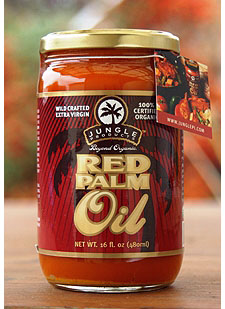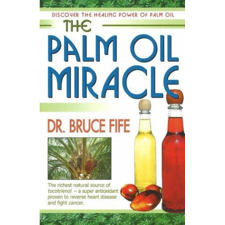Palm oil has been used as both a food and a medicine for thousands of years. It was prized by the pharaohs of ancient Egypt as a sacred food. In tropical Africa and Southeast Asia, it is an integral part of a healthy diet, just as olive oil is prized in the Mediterranean.
Palm Oil is one of the world's healthiest oils!
A natural vegetable oil, there are no trans fatty acids or cholesterol. Palm oil is the richest natural source of tocotrienol, making it a super antioxidant. These natural antioxidants act as scavengers of oxygen free radicals and are believed to play a protective role in cellular aging, atherosclerosis, cancer, arthritis, and Alzheimer's disease.
Red palm oil is a minimally processed palm oil that naturally contains tocopherols and tocotrienols (vitamin E), and carotenoids (vitamin A)—which gives the oil its red color.
How Does Red Palm Oil Compare to Other Oils?
- Red palm oil contains more antioxidants and vitamin E than any other oil.
- No other oil contains a significant amount of carotenes.
- Red palm oil contains a healthy balance of all types of fat: 10% polyunsaturated, 40% monounsaturated and 50% saturated fatty acids.
- Red palm oil remains stable when used for cooking.
- It is not hydrogenated, is not processed with heat or solvents such as hexane, and does not contain any trans-fatty acids
- Palm kernel oil and coconut oil are rich in lauric acid. Palm oil, on the other hand, has very little lauric acid. It is rich in palmitic and oleic acid.
- Olive oil, which has typically been considered the healthiest cooking oil, is low in polyunsaturated fatty acids and vitamin E, high in monounsaturated fatty acids, and does not remain stable when used for cooking.
Advantages of Cooking with Red Palm Oil
Palm oil possesses excellent cooking properties. It is more heat stable than other vegetable oils. It imparts superior taste, texture and quality in foods and baked goods. Red palm oil remains stable even when used in recipes calling for high temperatures.
Most oils become rancid from exposure to heat, light, and oxygen. Red palm oil is naturally protected by its high levels of vitamin E antioxidants, and has a natural resistance to oxidation and rancidity. It can be safely used for cooking, and in fact, a study examining the cooking of red palm oil at high temperatures showed that it does not have an adverse effect on blood lipids. It also contains a very low concentration of linolenic acid and only a moderate proportion of linoleic acid, the most readily oxidized components of oils, making it even more resistant to rancidity. For an oil that contains essential fatty acids, palm is surprisingly stable for use in cooking.
Our favorite recipes using palm oil (Found in The Palm Oil Miracle by Dr. Bruce Fife)
- Malaysian Fried Chicken
- Pan Fried Pork Chops
- Kale and Onions
- Sauteed Green Beans
- Palm Oil Mayonnaise
- Cider Vinegar and Palm Oil Salad Dressing
Red palm oil presents the most sustainable option among edible oils due to its high yields, providing work to thousands of people throughout Southeast Asia. Red palm oil could satisfy the world's demands for healthy oils and fats without straining the earth's limited land and energy resources … and it's an excellent, multi-purpose oil that is a healthy addition to your pantry!
Buy Jungle Palm Oil and Save 15% on the book, The Palm Oil Miracle! |
 |
